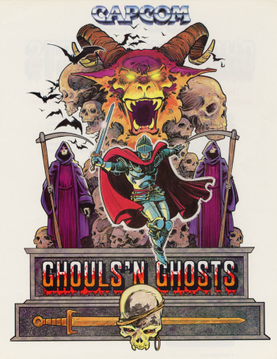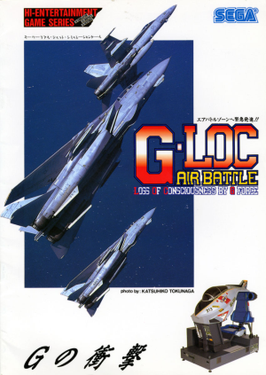
Ghouls 'n Ghosts, known as Dai Makaimura in Japan, is a side-scrolling platform game developed by Capcom, released as an arcade video game in 1988 and ported to home platforms. It is the sequel to Ghosts 'n Goblins and the second game in the Ghosts 'n Goblins series.

Wonder Boy in Monster Land, known by its original arcade release as Wonder Boy: Monster Land, is a platform video game developed by Westone Bit Entertainment and released by Sega in Japanese arcades in 1987 and for the Master System in 1988, with a number of other home computer and console ports following. The game is the sequel to the 1986 game Wonder Boy and takes place eleven years after the events in the previous game. After enjoying over a decade of peace on Wonder Land following the defeat of the evil King by Tom-Tom, later bestowed the title "Wonder Boy", a fire-breathing dragon called the MEKA dragon appeared; he and his minions conquered Wonder Land, turning it into "Monster Land". The people, helpless due to their lack of fighting skill, call for Wonder Boy, now a teenager, to destroy the monsters and defeat the MEKA dragon. Players control Wonder Boy through twelve linear levels as he makes his way through Monster Land to find and defeat the MEKA dragon. Players earn gold by defeating enemies and buy weapons, armor, footwear, magic, and other items to help along the way.

After Burner is a rail shooter arcade video game developed and released by Sega in 1987. The player controls an American F-14 Tomcat fighter jet and must clear each of the game's eighteen unique stages by destroying incoming enemies. The plane is equipped with a machine gun and a limited supply of heat-seeking missiles. The game uses a third-person perspective, as in Sega's earlier Space Harrier (1985) and Out Run (1986). It runs on the Sega X Board arcade system which is capable of surface and sprite rotation. It is the fourth Sega game to use a hydraulic "taikan" motion simulator arcade cabinet, one that is more elaborate than their earlier "taikan" simulator games. The cabinet simulates an aircraft cockpit, with flight stick controls, a chair with seatbelt, and hydraulic motion technology that moves, tilts, rolls and rotates the cockpit in sync with the on-screen action.

Space Harrier is a third-person arcade rail shooter game developed by Sega and released in 1985. It was originally conceived as a realistic military-themed game played in the third-person perspective and featuring a player-controlled fighter jet, but technical and memory restrictions resulted in Sega developer Yu Suzuki redesigning it around a jet-propelled human character in a fantasy setting. The arcade game is controlled by an analog flight stick while the deluxe arcade cabinet is a cockpit-style hydraulic motion simulator cabinet that tilts and rolls during play, for which it is referred as a taikan (体感) or "body sensation" arcade game in Japan.

Operation Wolf is a light gun shooter arcade game developed by Taito and released in 1987. It was ported to many home systems.
Michael Jackson's Moonwalker is the name of several video games based on the 1988 Michael Jackson film Moonwalker. Sega developed two beat 'em ups, released in 1990; one released in arcades and another released for the Sega Genesis and Master System consoles. U.S. Gold also published various games for home computers the same year. Each of the games' plots loosely follows the "Smooth Criminal" segment of the film, in which Jackson rescues kidnapped children from the evil Mr. Big, and incorporates synthesized versions of some of the musician's songs. Following Moonwalker, Jackson collaborated with Sega on several other video games.

Bonanza Bros. is a 3D-style, 2D side-scrolling stealth action game developed and released by Sega in 1990. It is one of the earliest arcade games powered by the Sega System 24 arcade system board. It was ported to various home systems, including the Mega Drive/Genesis, Master System, PC-Engine/TurboGrafx-CD, and several home computers.

G-LOC: Air Battle is a 1990 combat flight simulator arcade video game developed and published by Sega. It is a spin-off of the company's After Burner series. The title refers to "G-force induced Loss Of Consciousness". The game is known for its use of the R360 motion simulator arcade cabinet. The arcade game was a commercial and critical success upon release.

Astron Belt (アストロンベルト) is a LaserDisc video game in the form of a third-person, space combat rail shooter, released in arcades in 1983 by Sega in Japan, and licensed to Bally Midway for release in North America. Developed in 1982, it was the first major arcade laserdisc video game. The game combines full-motion video (FMV) footage from the laserdisc with real-time 2D graphics. The arcade game was available in both upright and cockpit arcade cabinets, with the latter having illuminated buttons on the control panel, a larger 25" monitor, and a force feedback vibrating seat.

Alien Storm (エイリアンストーム) is a beat 'em up shooter released as an arcade video game by Sega in 1990. It was ported to the Genesis/Mega Drive and Master System. The Mega Drive version was re-released on Wii's Virtual Console in 2007 and was also included on Sonic's Ultimate Genesis Collection for Xbox 360 and PlayStation 3. The game was also re-released on the Nintendo Switch Online + Expansion Pack in 2022.

Steel Gunner is a 1990 first-person shooter arcade game developed and published by Namco. Players take control of Garcia and Cliff, a duo of police officers that are part of the Neo Arc police force, as they must use their powerful Gargoyle mecha suits to destroy the STURM terrorist organization, who have taken captive scientists Dr. Ryan and Dr. Ellis to create a world-ending superweapon. Gameplay revolves around using a crosshair to shoot down enemies and avoid harming civilians. It runs on the Namco System 2 Plus arcade hardware.

GP Rider is a motorcycle racing game developed and manufactured by Sega, released in as an arcade video game in Japan, North America and Europe. It came in a two-player motion simulator cabinet and a standard upright cabinet. It was ported to the Master System in 1993 and then Game Gear in 1994.

Super Monaco GP is a Formula One racing simulation video game released by Sega, originally as a Sega X Board arcade game in 1989, followed by ports for multiple video game consoles and home computers in the early 1990s. It is the sequel to the 1979 arcade game Monaco GP. The arcade game consists of one race, the Monaco Grand Prix, but later ports added more courses and game modes based on the 1989 Formula One World Championship.

Pac-Mania is a cavalier perspective maze game that was developed and released by Namco for arcades in 1987. In the game, the player controls Pac-Man as he must eat all of the dots while avoiding the colored ghosts that chase him in the maze. Eating large flashing "Power Pellets" will allow Pac-Man to eat the ghosts for bonus points, which lasts for a short period of time. A new feature to this game allows Pac-Man to jump over the ghosts to evade capture. It is the ninth title in the Pac-Man video game series and was the last one developed for arcades up until the release of Pac-Man Arrangement in 1996. Development was directed by Pac-Man creator Toru Iwatani. It was licensed to Atari Games for release in North America.

Enduro Racer (エンデューロレーサー) is an arcade racing game from Sega. It was released in 1986 with two arcade cabinet versions, a stand-up cabinet with handlebars and a full-sized dirt bike cabinet. It is often seen as a dirt racing version of Hang-On, as it uses a similar engine and PCB. The game was later released for the Master System in 1987, the ZX Spectrum and Commodore 64 in 1988, and the Amstrad CPC and Atari ST in 1989.

Crack Down (クラックダウン) is a run and gun arcade game released by Sega in 1989 and ported to the Sega Mega Drive/Genesis in 1990 in Japan and 1991 in North America by Sage's Creation. It was also ported and released to a number of home computer platforms by U.S. Gold.

Galaxy Force is a rail shooter video game developed and released by Sega for arcades in 1988. The player assumes control of a starship named the TRY-Z, as it must prevent the Fourth Empire from taking over the entire galaxy. Gameplay involves shooting down enemies using either a laser shot or a limited supply of heat-seeking missiles, all while avoiding collision with projectiles or obstacles and making sure the ship's energy meter doesn't fully deplete. It ran on the Sega Y Board arcade system, and was released with a motion simulator cockpit arcade cabinet version like previous Sega Super Scaler games.

Turbo is a racing game released in arcades in 1981 by Sega. Designed and coded by Steve Hanawa, the game received positive reviews upon release, with praise for its challenging and realistic gameplay, 2.5D color graphics with changing scenery, and cockpit sit-down arcade cabinet. It topped the monthly Play Meter arcade charts in North America and ranking highly on the Game Machine arcade charts in Japan.

Line of Fire is a first-person light gun shooter game developed by Sega and released for arcades in 1989. It was released with two arcade cabinet versions, a standard upright and a sit-down cockpit, both featuring two positional guns. The cockpit design allows the player(s) to sit down while playing the game, while having two-handed machine guns, controlled by a potentiometer-controlled gun alignment software system. The game follows a two-man commando unit as they try to escape from a terrorist facility after seizing a prototype weapon.

Gun Buster, also known as Gunbuster (ガンバスター) and released in North America as Operation Gunbuster, is a first-person shooter video game developed by Taito and released for arcades in 1992. In contrast to on-rail light gun shooters at the time, this was one of the first arcade games to feature free-roaming FPS gameplay, the same year Wolfenstein 3D was released on personal computers.




















